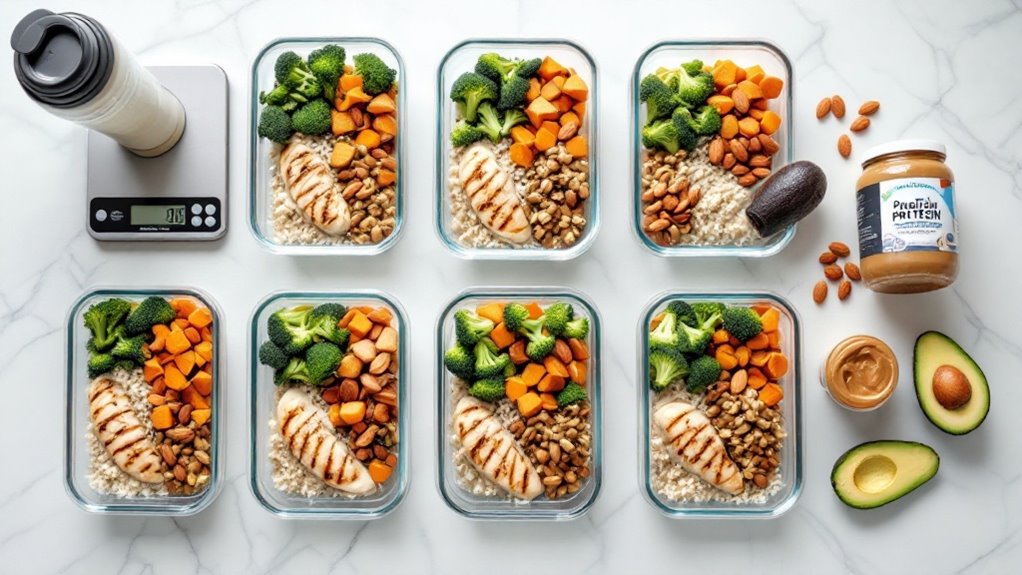Bulking Fitness Plan

A successful bulking fitness plan combines strategic resistance training with proper nutrition and recovery protocols. The program focuses on progressive overload through compound movements at 70-85% of one-rep maximum, while maintaining a 10-20% caloric surplus with high protein intake. Training each muscle group 2-3 times weekly, with 48-hour recovery periods, optimizes growth. Tracking metrics like weight, strength gains, and body composition guarantees steady progress. This systematic approach transforms random workouts into scientific muscle building.
Key Takeaways
- Maintain a caloric surplus of 10-20% above maintenance while consuming 1.8-2.2 grams of protein per pound of bodyweight.
- Train each muscle group 2-3 times weekly using compound movements like squats, deadlifts, and bench presses at 70-85% max.
- Get 7-9 hours of sleep nightly and allow 48 hours between training sessions of the same muscle group.
- Track weekly weight, strength gains, and body composition measurements to ensure consistent progress and make necessary adjustments.
- Focus on progressive overload in training while maintaining proper form and adequate rest periods of 1-3 minutes.
Training Principles for Maximum Muscle Growth

When it comes to building maximum muscle mass, understanding and implementing proper training principles serves as the foundation for successful bulking. The key principles include progressive overload, adequate volume, and proper form execution.
Training intensity must focus on compound movements like squats, deadlifts, and bench presses, performed at 70-85% of one-rep maximum.
Rest periods between sets should range from 1-3 minutes to enhance muscle recovery and performance.
Frequency matters – each muscle group requires 2-3 training sessions per week with sufficient recovery time.
This systematic approach, combined with proper nutrition and rest, creates the ideal environment for muscle hypertrophy.
Using a digital workout calendar helps eliminate decision fatigue by organizing your training schedule in advance and tracking your progress over time.
Nutrition Strategy for Building Mass

Proper nutrition serves as the foundation of any successful bulking program, accounting for approximately 70% of muscle-building results.
Success hinges on creating a sustainable caloric surplus while maintaining ideal macronutrient ratios.
Athletes must consume 10-20% above their maintenance calories, prioritizing lean protein sources at 1.8-2.2 grams per pound of body weight.
Complex carbohydrates should comprise 45-55% of total calories, fueling intense training sessions.
Healthy fats, at 20-30% of intake, support hormone production and recovery.
Meal timing becomes essential, with strategic pre and post-workout nutrition windows maximizing muscle protein synthesis and glycogen replenishment.
Implementing progressive overload principles during training ensures continued muscle growth when combined with proper nutritional intake.
Essential Recovery and Rest Protocols

Recovery protocols are the bedrock of muscle growth, working in perfect synergy with nutrition and training. Proper rest allows muscles to repair and strengthen while preventing overtraining and potential injuries.
- Sleep 7-9 hours nightly to optimize hormonal balance and muscle protein synthesis.
- Allow 48 hours between training the same muscle groups to guarantee complete recovery.
- Implement active recovery days with light cardio and mobility work.
- Use recovery tools like foam rollers and massage guns to reduce muscle soreness.
These protocols enhance the body's natural ability to build lean mass while minimizing the risk of burnout and plateaus.
While resistance training intensity should remain high during recovery periods, consider reducing overall workout volume to support optimal recovery.
Measuring Progress and Adjusting Your Bulk

Tracking progress systematically during a bulk guarantees that gains are optimized and adjustments can be made before momentum is lost. Key metrics include weekly weight measurements, monthly body composition scans, progress photos, and strength logging.
Strategic adjustments to caloric intake and training volume become necessary when progress plateaus. A 200-300 calorie increase can jumpstart growth while maintaining a lean bulk.
Performance indicators like rep quality, workout recovery time, and energy levels guide these modifications. Exercises like seated lat pulldowns help track upper body strength development while maintaining proper form.
Documentation through a fitness app or journal creates accountability and reveals patterns. This data-driven approach transforms bulking from guesswork into a precise science of continuous improvement.
Frequently Asked Questions
Can I Bulk Without Using Protein Supplements?
Natural protein sources like eggs, chicken, fish, lean meats, Greek yogurt, and legumes make protein supplementation completely optional for bulking.
The key is consuming adequate protein through whole foods – approximately 1.6-2.2g per kg of body weight daily.
Smart meal planning, frequent protein-rich meals, and caloric surplus will support muscle growth effectively without powder supplements.
Consistency in nutrition matters more than supplement choices.
How Do Genetics Affect My Ability to Gain Muscle Mass?
Like a seed's potential to grow into a mighty oak, genetics provide the blueprint for muscle development.
Genetic factors influence muscle fiber composition, hormone levels, and metabolism rate. Some individuals naturally build muscle faster due to higher testosterone levels or more favorable muscle fiber types.
However, genetics are not destiny – proper training and nutrition can help anyone achieve significant muscle growth within their genetic potential.
Should I Continue Bulking if I Catch a Cold or Flu?
When sick with a cold or flu, the body needs energy to fight the infection rather than build muscle.
Reducing training intensity and caloric intake temporarily is recommended until recovery.
While complete rest may be necessary for severe symptoms, maintaining protein intake helps preserve muscle mass.
Once symptoms improve and energy levels normalize, gradually return to regular bulking routines and caloric surplus.
Will Bulking Affect My Cardiovascular Endurance Negatively?
Bulking typically won't greatly impact cardiovascular endurance if done properly.
The key is maintaining regular cardio training while increasing caloric intake.
Any minor decrease in endurance usually stems from carrying extra body weight rather than the bulking process itself.
Athletes can maintain their cardiovascular fitness by incorporating strategic cardio sessions, keeping intensity moderate, and focusing on progressive resistance training alongside endurance work.
Is It Possible to Bulk Effectively While Following a Vegetarian Diet?
Yes, vegetarians can bulk effectively by focusing on high-protein plant sources like legumes, quinoa, tofu, tempeh, seitan, and protein-fortified foods.
Strategic meal planning guarantees adequate protein intake through combinations like rice with beans or pea protein supplements.
A balanced vegetarian bulk requires attention to complete proteins, caloric surplus, and essential nutrients like B12, iron, and zinc through supplements or fortified foods.
Final Thoughts
Through dedication to proven training principles, strategic nutrition, and proper recovery protocols, aspiring muscle architects can sculpt their ideal physique. The journey of transformation from average to impressive requires both sweat equity and intelligent planning. By consistently measuring progress and fine-tuning the approach, determined individuals can watch their hard work bloom into tangible results, turning their vision of a stronger, more muscular self into reality.


